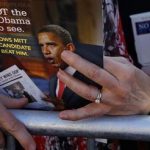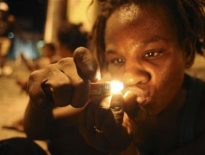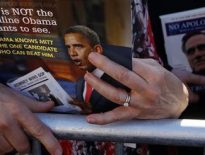(Reuters) – Tracy Martin had been looking for his son Trayvon since the night before. He went
to bed figuring the teen must have gone to the movies and turned off his phone. When Trayvon still wasn’t home in the
morning, Martin called the police.

After a flurry of phone calls back and forth, an officer
told him a police unit was on the way. “So I went outside waiting for Trayvon to show up,” Martin said.
Instead of one
squad car with his son in the backseat, three vehicles pulled up: a police cruiser, an unmarked sedan and another
official-looking car. Martin would discover the third car belonged to a chaplain.
It was not yet 8 in the morning,
barely 12 hours since the shooting that took place about 100 yards away, and Martin was still unaware of the fate of his
son.
The February 26 shooting death of Trayvon Martin, 17, at the hands of George Zimmerman, 28, a neighborhood watch
captain who said he acted in self-defense, has riveted the nation, largely because of race. Trayvon Martin was black. George
Zimmerman is white and Hispanic.
For about 10 days, the story remained obscure. Television news from nearby Orlando
aired a few segments. The Orlando Sentinel published two brief articles, and the twice-weekly Sanford Herald ran 213 words.
Otherwise, there was media silence. This is an account of what happened before everyone knew Trayvon Martin’s
name.
BREAKING THE NEWS
When Tracy Martin greeted the police that morning, a plainclothes detective asked him
to describe his son. “He asked me what he last had on. He asked me if I had any recent pictures,” Martin said.
“I
showed him a recent picture in the camera and he shook his head and said, ‘OK, let me go to my car and get something.'” The
detective returned with a folder.
It was drizzling, and he asked Martin if they could go inside. When they were seated
he pulled out a photo. It was Trayvon, dead at the scene – his eyes rolled back, a tear on his cheek, saliva coming from his
mouth. “From that point, our nightmare,” Martin said.
“YOU GOT ME”
The night his son was killed, Martin, 45,
was out to dinner with his fiancée, Brandy Green. Martin, who was divorced from Trayvon’s mother, Sybrina Fulton, in 1999,
is a truck driver from Miami who has a long-distance relationship with Green, a resident of the Retreat at Twin Lakes
subdivision in Sanford where Zimmerman also lived.
Martin would visit Green on weekends, making the four-hour drive to
the Orlando suburb of Sanford. In late February he was able to bring his son because Trayvon, a junior, was serving a 10-day
suspension from Miami’s Dr. Michael M. Krop Senior High School. He’d been caught with a plastic baggie that contained
traces of marijuana.
On Wednesday, the day after receiving the news, Martin went to the Sanford Police Department
looking for answers – and his son’s body. Police took him to a room and played some of the 911 recordings of neighbors who
called to report a disturbance followed by a gunshot.
They did not play an earlier call to a police non-emergency
line, during which Zimmerman reported a “suspicious guy” and ignored the operator’s suggestion to quit following him.
Investigator Chris Serino then took Martin to another room and told him Zimmerman’s version of events.
Sanford police
have stopped talking to reporters about the case, and Serino has never spoken publicly about his role in it, but here is how
Martin recalls what Serino said: “He told me Zimmerman’s story was that Zimmerman was of course following him and that
Trayvon approached his vehicle, walked up to the car and asked Zimmerman, ‘Why are your following me?’ Zimmerman then rolls
his car windows down, tells Trayvon ‘I’m not following you.’ He rolls his car windows up.
“Trayvon walks off.
Zimmerman said he started running between the buildings. Zimmerman gets out of his car. He comes around the building. Trayvon
is hiding behind the building, waiting on him. Trayvon approaches him and says, ‘What’s your problem, homes?’ Zimmerman
says ‘I don’t have a problem.’
“Zimmerman starts to reach into his pocket to get his cellphone, and at that point
Trayvon attacked him. He says Trayvon hits him. He falls on the ground. Trayvon jumps on top of him, takes his left hand and
covers Zimmerman’s mouth and tells him to shut the F up and continues to pound on him.
“At that point Zimmerman is
able to unholster his weapon and fire a shot, striking Trayvon in the chest. Trayvon falls on his back and says, ‘You got
me.'” The Martin family has been telling their story as part of a campaign to have Zimmerman arrested. He himself has kept
quiet.
Sanford police have declined numerous requests for comment on any aspect of the story, even before a special
prosecutor overseeing the case invoked a state law that restricts otherwise public information in the course of an active
criminal investigation.
Zimmerman has not spoken publicly, since any statements he makes could affect future
litigation against him. Though he is free, he remains in hiding.
His father, brother, and defense lawyer, Craig
Sonner, have said in interviews that Zimmerman is not racist and has been unfairly vilified. He feared for his life during
his altercation with Trayvon Martin, they say, and was justified in using deadly force. In his conversation with Martin,
Serino referred to Zimmerman’s background as “squeaky clean.”
Zimmerman had been arrested in 2005 for shoving a state
alcohol agent officer during an argument at a bar. Charges were dropped after he entered a special program for first-time
offenders. Later that year, his then-girlfriend took out a restraining order, accusing him of domestic
violence.
Sanford police released Zimmerman without charge, but Martin says Serino told him he would challenge
Zimmerman’s account. “The detective’s words were, ‘I want to interview him again to catch him in a lie,'” Martin
said.
A law-enforcement source, who had been informed of the case by investigators, told Reuters that Serino was eager
to bring a charge but encountered resistance from the office of the prosecutor, State Attorney Norman
Wolfinger.
“Chris (Serino) would have made a recommendation for manslaughter, but Norm Wolfinger’s office wanted it
to be a slam dunk,” said the source, who spoke on condition of anonymity. “They don’t want to hear that this is wrong or
that is wrong with the case. That’s the way this county does business.” Wolfinger on Monday broke a long silence about the
case, denying reports he quashed police intentions to charge Zimmerman with manslaughter.
Although police found no
contradictions within Zimmerman’s story, their decision not to arrest Zimmerman was lambasted by critics and has sparked
demonstrations around the country.
For now there is one arbiter who matters. Special Prosecutor Angela Corey, a state
attorney from northern Florida appointed by Scott on March 22, has taken over the investigation and will decide whether
charges are warranted.
ZIMMERMAN DROPS OUT OF SIGHT
Immediately after the shooting, while waiting for police to
arrive, neighbor Selma Mora Lamilla saw Zimmerman pacing back and forth, holding his head in his hands. “He was like, ‘Oh my
God, what just happened?'” said Mora Lamilla’s roommate, Mary Cutcher.
Zimmerman understood the magnitude of his
situation right away, said Joe Oliver, a family friend and colleague of Zimmerman’s at mortgage risk management firm Digital
Risk LCC.
“The day after, he went into his job to let them know what was going on,” said Oliver, who has spoken to
Zimmerman at least twice since the shooting. “That is the last I know of anyone seeing George.”
Zimmerman and his wife
moved out of the townhouse they rented in the Twin Lakes complex almost immediately, Oliver said, and they are now living in
seclusion. Across town in Sanford’s black neighborhood, word spread quickly that a black teenager had been
killed.
The shooter, said to be white, had gone free. As in many cities in the South, Sanford has a long history of
racial tension, and black mistrust of the police runs deep. In 2011, a previous Sanford police chief was forced out of the
job after a white police officer’s son was captured on video sucker-punching a black homeless man outside a
bar.
Sanford police did not arrest the assailant until video of the attack surfaced on local TV and provoked an outcry
from Sanford civil rights leaders. Now, once again, anger was building. A rumor that superiors had quashed an investigator’s
intent to charge Zimmerman had already made the rounds in the black community, said Velma Williams, the only black member of
the five-person Sanford city commission.
“People were getting suspicious, saying we knew that was going to happen
based on history,” Williams said in an interview. She went to see Police Chief Bill Lee on Thursday, March 1, four days after
the shooting.
“I told him, ‘I can see a train coming down the track at 50 miles an hour, and you better get a handle
on this,'” Williams said. “He said to me, ‘You can rest assured that it’s a thorough and objective and fair
investigation.'”
Three weeks later, on March 22, when there was still no arrest and the city commission had voted “no
confidence” in Lee by 3-2, the chief announced his temporary resignation. Lee told a news conference that while he stood by
the Sanford Police Department, he was stepping aside.
“It is apparent that my involvement in this matter is
overshadowing the process,” he said. “I do this in the hopes of restoring some semblance of calm to the city, which has been
in turmoil for several weeks.”
TRAYVON MARTIN AS JOHN DOE
At the time of the shooting, Trayvon Martin was not
carrying identification – only $22, a cellphone, and the now familiar bag of candy and can of iced tea. His body, taken to
the Volusia County Medical Examiner’s office, was tagged as a John Doe.
Although Martin had identified his son to
police on Monday, February 27, and asked Serino the next day to issue police clearance for releasing the body, not until
Wednesday was a funeral director permitted to drive it back to South Florida. In Miami, the boy’s mother, Sybrina Fulton,
46, a program coordinator for the Miami Dade Housing Authority, stayed home in bed.
“Every little thing kind of
frustrates you, especially if you don’t have the body … Just to know the funeral home had the body gave us some comfort,”
Fulton said.
“I cried every day. There was nothing else I could do as a mother. Thank God his dad was able to run
around and take care of things,” she said. The family held a viewing on Friday, March 2. The memorial service and interment
were Saturday. The painful work of laying Trayvon to rest was complete. Now would begin the more difficult search for
justice.
FINDING BEN CRUMP
Tracy Martin and Sybrina Fulton wanted George Zimmerman arrested. They believe he
stalked their son because he was black, and they were outraged that Sanford police had accepted Zimmerman’s claim of
self-defense.
Lee, the police chief, would contend under Florida’s “Stand Your Ground” law that police could not
arrest Zimmerman without evidence to contradict his story. Martin turned to Patricia Jones, his sister-in-law.
An
attorney herself, she knew whom to call: Benjamin Crump, the state’s best-known civil rights attorney, based in Tallahassee.
Crump and law partner Daryl Parks had previously gained renown representing the family of a black teenager who died in a
boot-camp-style youth detention center in 2006, winning the boy’s family $7.2 million in damages from the state of Florida
and Bay County.
On Tuesday, February 28, Crump was at the Duval County Courthouse in Jacksonville, about 125 miles
north of Sanford, arguing that public records should be released in civil litigation over Antonio Cooks. Cooks, a black bail
bondsman, had been shot and killed by Jacksonville Sheriff’s Officer Jason Bailey while Cooks was serving a warrant and
Bailey was responding to a burglary call.
During a break in the hearing, Crump noticed messages from Tyrone Williams,
another attorney he knows, and Jones. They urgently asked for his help. Soon Jones put him in touch with Tracy
Martin.
“I told him to believe in the system,” Crump said of that first call. “I really believed they were going to
arrest Zimmerman. I said, ‘He’s a neighborhood watch person with a gun. Of course they are going to arrest him just for
that.'” “Then 48 hours passed and they still hadn’t arrested him,” Crump said. “After that we just had to do what we had to
do.”
He took the case pro bono. Realizing he needed a lawyer who knew Sanford and Seminole County, Crump turned to
Natalie Jackson, a former Navy intelligence officer who founded the Women’s Trial Group, which specializes in cases for
women and children. Her mother lives in Sanford.
Now Crump and Jackson needed a media strategy. On March 5, Jackson
brought in Ryan Julison, a publicist who had worked with her on a number of high-profile cases. After speaking with Tracy
Martin, Julison said he also took the job for free and went to work pitching the story to national media.
Crump knew
from his experience on the boot-camp case that publicity could force officials to act, but it would require persuading two
people who had never stood before a television camera to withstand the spotlight.
“I got on the phone with Tracy
Martin and I told him, ‘It’s not going to be any fun, but this is the only way to find justice,'” Julison said. “You are
going to have to bare your soul and express your emotions and your inner grief.” Martin and Fulton agreed. There was only one
problem. At first, the media weren’t interested. Julison pitched the story to a long list of media
contacts.
Eventually, on March 7, Reuters published a story titled “Family of Florida Boy Killed by Neighborhood Watch
Seeks Arrest.” The next day, CBS News aired a segment on “This Morning,” and by 10 a.m. a crowd of reporters gathered at
Natalie Jackson’s law office for a news conference with Ben Crump and Tracy Martin. A media firestorm had
begun.
EPILOGUE: THE 911 RECORDINGS
The day after the news conference, on March 9, Velma Williams went back to
see Police Chief Bill Lee with community activist Kenneth Bentley. “We said, look, chief. Last time I was here I told you a
train was coming down the tracks and it was going 50 miles an hour,” Williams recalled.
“I said it’s going 150 miles
an hour now. And it doesn’t have any brakes.” Back in New York, civil rights activist Al Sharpton was monitoring events, his
interest piqued by an earlier call from Crump.
After the police chief told reporters on March 12 he lacked a probable
cause to arrest Zimmerman, Sharpton took up Trayvon Martin’s cause on his MSNBC show, fueling cable television
competition.
The twist that catapulted Martin’s shooting into a world story was the release of recorded 911 emergency
calls, including one that captures screams for help in the background that end with a gunshot.
Chief Lee had resisted
Crump’s requests to make the tapes public, but he was overruled by Sanford Mayor Jeff Triplett. On the night of Friday,
March 16, Triplett invited Trayvon Martin’s parents and their legal team into his office to listen to each of the calls,
which he played on his computer.
“When we got to the cries for help, that was when Sybrina burst into tears,” recalled
Jackson. “She said, ‘That’s Trayvon. That’s our son.’ She ran out of the room crying.” (Zimmerman’s brother, Robert,
would later swear the voice belonged to George.)
“The mayor himself started to cry,” Jackson said. “Everybody in the
room was in tears.” Mayor Triplett overruled his police chief and distributed disks of the phone calls to the media that
night. They have been broadcast unceasingly ever since.
(Reporting by Daniel Trotta; Editing by Lee Aitken and Prudence
Crowther)





